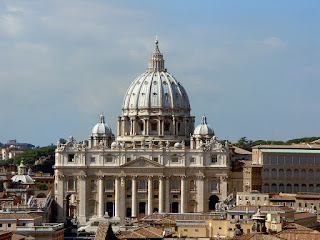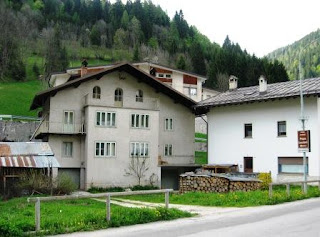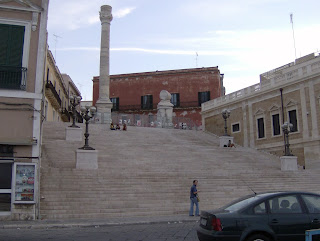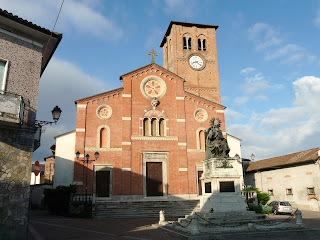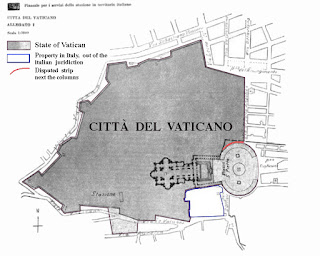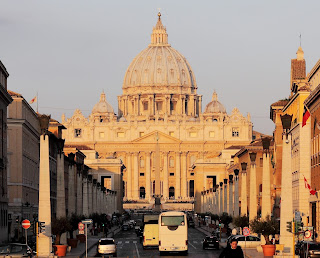First Pope to choose a regnal name
 |
| The portrait of John II in the Rome Basilica of St Paul Outside the Walls |
John had considered his birth name of Mercurius to be inappropriate as it honoured the pagan god, Mercury.
He chose John as his regnal name - or reign name - in memory of Pope John I, who was venerated as a martyr.
Mercurius was born in Rome and became a priest at the Basilica di San Clemente, a church with ancient origins near the Colosseum.
At that time in history, simony - the buying and selling of church offices - was rife among the clergy.
After the death of Pope John II’s predecessor, there was an unfilled vacancy for more than two months, during which some sacred vessels were sold off.
The matter was brought to the attention of the Roman Senate, which passed its last-known decree, forbidding simony in papal elections.
This decree was confirmed by the Gothic King, Athalaric, who ordered it to be engraved in marble and placed in St Peter’s Basilica.
 |
| Byzantine Emperor, Justinian I, portrayed in mosaic in Ravenna's Basilica of San Vitale |
It is not known for certain how Mercurius obtained the papal chair, but during that period the favour of kings was important for anyone who wanted to become Pope.
Athalaric always remained on good terms with Pope John II and referred all actions brought against the Roman clergy to him for his judgment.
John II was also obviously in favour with the Byzantine Emperor, Justinian I, who is recorded as having sent him some valuable gifts.
During his two-year reign as Pope, John had to deal with the adulterous behaviour of the Bishop of Riez in Provence. He ordered him to be confined to a monastery and, until a replacement could be appointed, he told the clergy in the area to take their instructions from the Bishop of Arles.
Before his death, John received a question from a council of bishops in Carthage about whether bishops who had lapsed into arianism should, on repentance, keep their rank or be admitted only to lay communion.
Before he could answer the question, John died in May 535 and was buried in St Peter’s Basilica. He was succeeded by Pope Agapetus I, who kept his real name and answered the question posed by the bishops to his predecessor.
Popes after John II all kept their real names until Pietro Canepanova was chosen in 983.
He did not want to use the name of St Peter, who was the first Pope, and so he styled himself John XIV.
He was followed by Giovanni di Gallina Alba, who kept his birth name and became John XV. After his death, popes began choosing a regnal name on a regular basis.
The most popular papal name chosen over the centuries has been John. It was last used between 1958 and 1963 by Pope John XXIII, who was born Angelo Roncalli.
 |
| The garden and facade of the Basilica of San Clemente |
The Basilica of San Clemente in Rome, where Pope John II had previously served as a priest, is in Via Labicana, close to the Colosseum and the Parco del Celio. It is an interesting, three-tiered building. The present basilica was built in the 11th century, but underneath there is a fourth-century basilica, converted from the home of a Roman nobleman, where John II would have served as a priest. The floor below that had been a republican villa, which had briefly served as a mithraeum, a temple for the cult of Mithras, a religion popular with Roman soldiers that rivalled Christianity. The novelist Ngaio Marsh was fascinated with the Basilica and used it as the model for a fictitious church in Rome, which she uses as the crime scene in her Roderick Alleyn mystery, When In Rome.
Travel tip:
Pope John II was buried in the old St Peter’s Basilica in 535. But his tomb was believed to have been destroyed during the demolition of the old church and the building of the new Basilica in the 16th and 17th centuries. Some of the tombs of dead popes were reburied in the new Basilica, while some were moved to other places, but the final resting place for many of them is still uncertain. There is a plaque in St Peter’s listing the popes buried in the Basilica and Pope John II’s name appears in the list, even though the exact location of his tomb is not known.
More reading:
Pope Leo X - the Medici pope
The completion and consecration of St Peter's
Pope John Paul II visits his would-be killer in prison
Also on this day:
Books:
(Picture credits: Mosaic by Petar Milošević; Basilica of San Clemente by Dudva; via Wikimedia Commons)
Home
.

